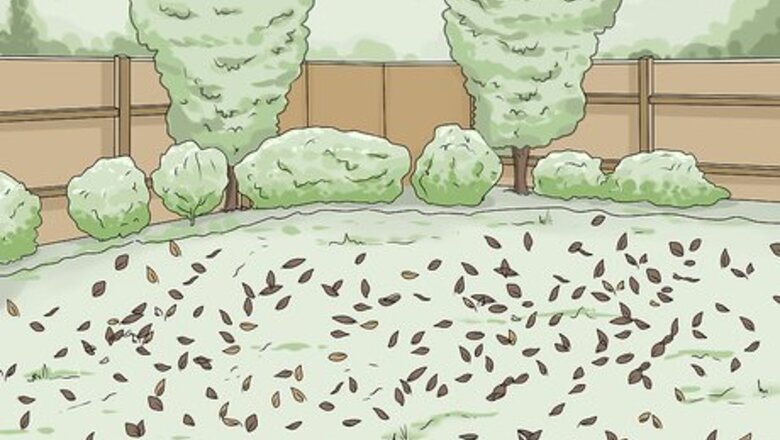
views
X
Research source
Making Humus from Leaves
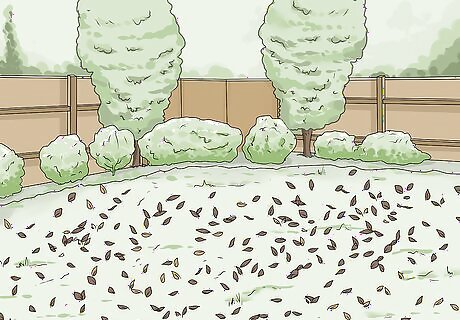
Let leaves gather on your lawn for a few weeks or months. Leaves are the main ingredient you’ll need to make humus, so allow your trees to shed as many leaves as they like. If you don’t have trees, ask your neighbors if you can gather and take the leaves that fall on their lawns. Lots of people rake their leaves into a garbage bag and set them on the curb for waste collection, so keep an eye out for bags of leaves when you’re driving around. Don’t feel bad about taking them because you’ll be putting them to good use! If possible, avoid using the leaves from beech, oak, holly, and sweet chestnut trees because they’re lower in nitrogen and calcium. Leaves from black walnut and eucalyptus trees should especially be avoided because they contain natural herbicides.
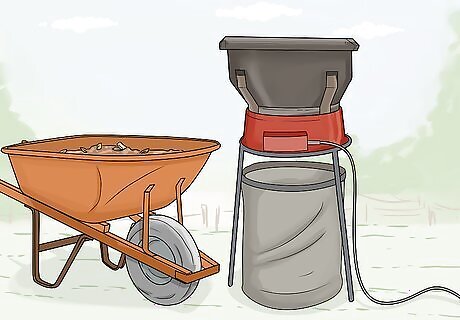
Shred the leaves using a shredder so they decompose faster. Shredded leaves are easier to work with and will decompose much faster than whole leaves. If you have a leaf shredder, rake the leaves into a bucket and dump them into the shredder placed over a tarp or another bucket so you can easily pour them into a pile or other container. You can also use a lawnmower to shred the leaves. Shredded leaves can turn into compost in just 2 to 4 weeks versus whole leaves that can take 6 to 12 months to break down.
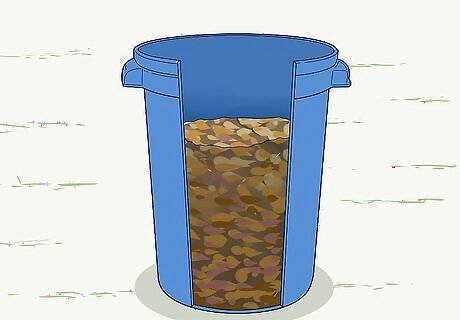
Transfer the shredded leaves into a large wire or mesh container. A tall wire or mesh container will allow air to flow between the leaves, helping the microbes break down the leaves into compost much faster. You can buy a mesh composting container at any garden store or make your own. Place the leaf container into an area that doesn’t get a lot of wind or cover the container with a plastic tarp to prevent the leaf shreddings from blowing away. A container with a height of 4 feet (1.3 yd) and a diameter of 4 feet (1.3 yd) will hold 17.5 square feet (1.63 m) and 35 square feet (3.3 m) of shredded leaves. You can also make a square container by driving 4 wooden posts into the ground, wrapping chicken wire around them, and securing the sides with heavy-duty twist ties or rope.
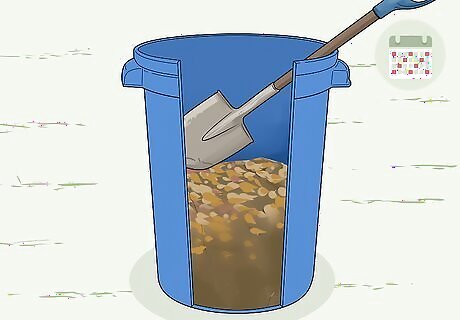
Turn the leaves every 3 to 7 days or as needed for your environment. Turning the leaves will increase airflow to the microbes inside the leaf pile, which are responsible for breaking down the leaves into compost. Insert a square-point garden shovel or pitchfork into the center of the pile, reaching down as far as you can. Then, bring the bottom leaves up to the sides of the pile (almost like you’re whisking egg whites for baking). Repeat this process until the center parts are on the sides and the sides are in the center. If you live in a hot or humid environment, turn the compost bin more often (every 3 or 4 days) for faster decomposition. If you live in a cold or dry environment, you can get away with only turning the leaves every 2 to 6 weeks. If you’re using whole leaves, turn them every 2 weeks. You can wait 4 to 6 weeks between turnings, but doing it every 2 weeks will speed up the process.
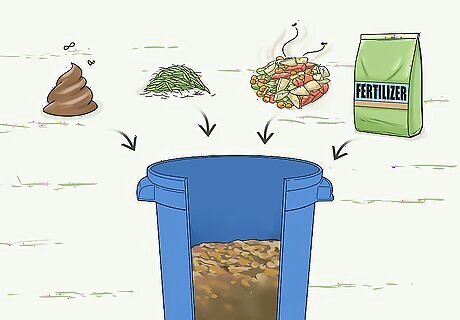
Add manure, grass clippings, food waste, or fertilizer if desired. While it’s not necessary to make healthy compost or humus, mixing in manure and other nitrogen-rich materials can speed up the process of decay. Use 1 part manure, clippings, food waste, or 10-10-10 fertilizer for 4 parts of leaves and mix it into the pile with a pitchfork or square-point garden shovel. Chicken, horse, cow, and rabbit manure are all great nutrient-rich options. You can buy bagged composting manure and 10-10-10 fertilizer from most nurseries and garden supply stores.
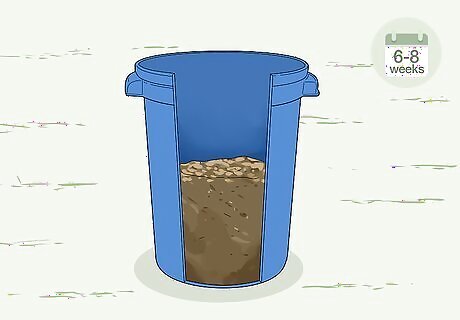
Wait 6 to 8 weeks for the leaves to turn into compost, then humus. As time passes, you’ll notice the leaf pile has decreased in volume—this is a sign that the microbes are doing a good job at breaking down the leaves. If you used shredded leaves, you may have compost as soon as the second or third week, but it will need another few weeks to a month to break down into humus. Continue the turn the pile as necessary during this process. If you notice the leaves are too dry and flaky, water the pile for about 5 seconds with a garden hose. If you’re using whole leaves, they’ll turn into compost in 6 to 12 months. It can take another year (or 2!) for that to turn into humus. You’ll know when you have humus when the compost turns into a moist brown or black soil with no more visible leaves.
Composting Food and Waste to Make Humus
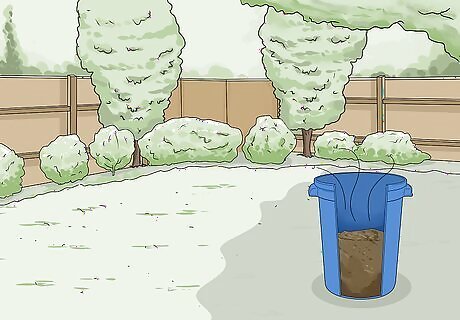
Choose a shady section of your yard to make the pile. Select a dry, shady area that’s far enough away from your house so it doesn’t smell but close enough that a hose can reach it. Make sure it’s accessible from all angles so you can turn the materials when necessary. If you have neighbors, make sure you’re putting it in a place where the smell won’t bother them. Some cities have rules about where you can place a compost pile, so check your area’s regulations to make sure you’re not breaking the law. If you don’t have a large backyard area, use a compost tumbler or spinner instead. You can buy them at most gardening supply or home hardware stores.
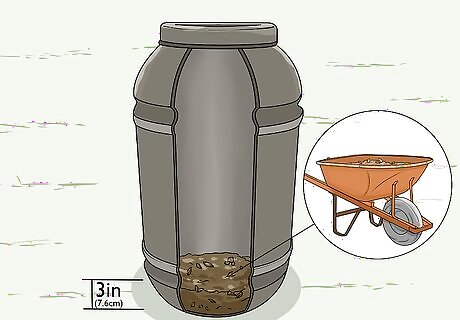
Layer the ground with 3 inches (7.6 cm) of carbon-rich materials. Start your pile with a layer of leaves, straw, hay, twigs, wood chips, small cardboard strips, or shredded paper. These materials will supply necessary carbon to the pile, which will help the microbes eat away at the materials and break them down into compost (and eventually, humus). If you’re using a tumbler bin, simply toss these materials into the barrel. Use enough to make a 3 inches (7.6 cm) layer in the center of the barrel. If you live in a very humid environment, you may need to add more mulch to prevent the compost from getting too moist.
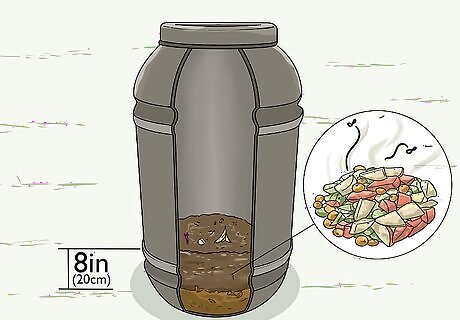
Fill the pile or bin with compostable materials. Keep a small bin inside your home to collect compostable kitchen scraps so you can add them to the outside pile. In addition to food scraps, you can compost a surprising number of things found around the house. Be sure to keep non-compostable materials out of your pile or bin because they can attract pests, promote disease, and spoil the nutrients. Compostable materials: Foods: fruits, vegetables, eggshells, nuts and nut shells (except walnuts), tea bags, coffee grounds, old herbs, and spices. Household items: coffee filters, tea bags, shredded newspaper, cardboard, paper, cotton balls (100% cotton), hair, fur. Natural materials: sawdust, wood chips, houseplants, grass clippings, yard trimmings, leaves, hay, straw. Do not compost: Dairy products: milk, butter, sour cream, yogurt, eggs (the yolk and whites). Fats: oils, grease, lard. Baked goods and grains: cake, cookies, pasta, rice. Meat products: All types of meat and fish (including the bones). Pet waste: feces, cat litter. Anything with pesticides: grass trimmings, tree trimmings, houseplants treated with pesticides. Things containing plastic or dyes: cigarette butts, glossy magazines, colored paper, markers, leather goods, coated coffee cups, coated milk or juice cartons.
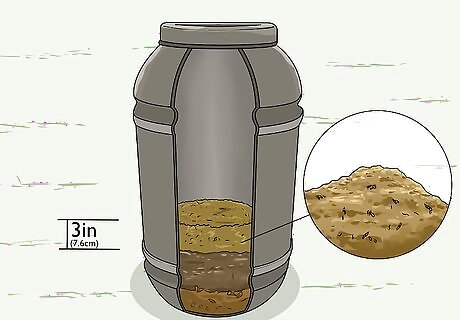
Add a 3 inches (7.6 cm) layer of mulch after every 8 inches (20 cm) of compostable scraps. Food waste and other compostable materials add more nitrogen to the pile, so you need to add more carbon-rich materials to balance it out and aerate the pile. Once you have 8 inches (20 cm) of nitrogen-rich materials on top of the first layer of mulch, add a 3 inches (7.6 cm) or 4 inches (10 cm) layer of wood chips, straw, hay, grass clippings, or leaves. Adding these layers will help air circulate throughout the pile, allowing microbes to do a better job of breaking down the waste.
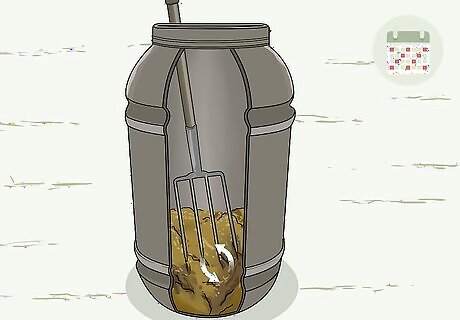
Turn the pile every 3 days to speed up the process of decomposition. Use a pitchfork or square-pointed shovel to transfer the material at the bottom center of the pile to the top outer edges of the pile and vice versa. Do this every 3 days to prevent it from overheating and keep smells to a minimum. If you’re using a tumbler or spinner, turn it around about 5 or 6 times and shake it back and forth to loosen up the materials inside. Do this about 2 to 3 times a week. If you notice your compost is dry in the center, add 64 fluid ounces (1,900 mL) of water to the pile while you’re turning it to moisten it up. Avoid turning the pile every day because this can disturb the fungi and microorganisms in the pile that are responsible for breaking it down.
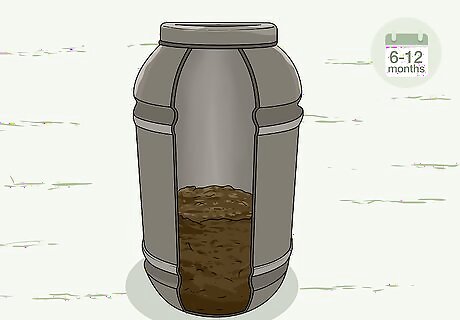
Maintain your compost pile for at least 6 to 12 months. The longer you keep your compost pile healthy, the more humus you’ll end up with. When you notice most of the pile has turned into compost, you can use that as fertilizer or keep tending to it for 6 to 12 months (or longer) until it turns into humus. Humus will look like dark brown or black soil without any leaves or other materials that can be broken down further. If you live in a chilly or cold environment, it can take years for compost to turn into humus so be patient!
Using Humus in Your Garden
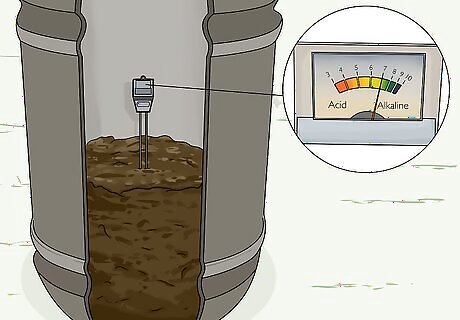
Test the soil’s pH level to see if it can benefit from a humus treatment. Soil that is too acidic or basic will inhibit the plants from taking in nutrients. Stick a pH stick into the ground—the proper range is between 6 and 8. If the soil is out of that healthy range, humus can help bring it into balance. Depending on your soil’s pH reading, you may need to add other elements like limestone to decrease acidity or sulfur to increase acidity before mixing in the humus. You can buy pH strip tests online, at nurseries, or from garden supply stores.
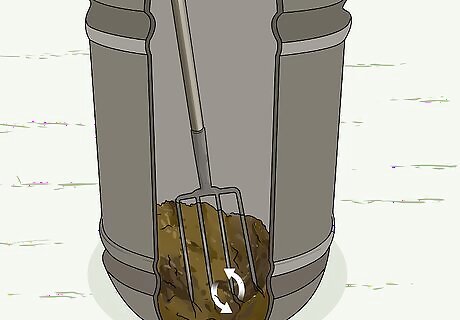
Stir the humus into your topsoil to correct soil that’s too sandy or too thick. Humus can help aerate and drain the soil, prompting more nutrient-producing organisms to grow and feed your plants. Use a pitchfork to mix humus into the top 7 inches (18 cm) to 12 inches (30 cm) of sandy or clay-like soil. For an area of 25 square feet (2.3 m), use 1 square foot (0.093 m) of humus. If your soil is too sandy and won’t hold water, humus will give it the sponge-like texture it needs to hold water. For thick, heavy soil (with lots of clay) that holds onto too much water, adding humus will help it form larger clumps (instead of small, sticky bits) so water doesn’t hang around and cause root rot.
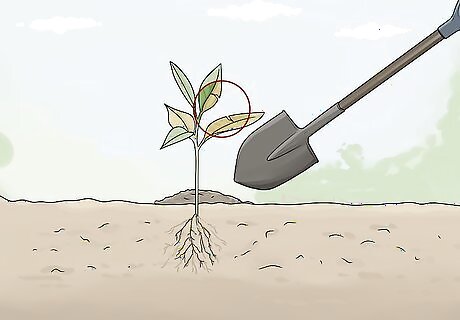
Discourage pests and prevent diseases in the soil with humus. Humus contains live microbes and bacteria that attract ants and spiders into the soil to eat harmful pests and larvae. Adding humus will also make the soil less vulnerable to pathogens that lead to various diseases. If you notice yellow or brown spots on your plant’s leaves or crinkling, oozing, and other signs of disease, treat the soil with humus over the course fo 2 days. For instance, for a small potted plant, pour in enough humus to make a 1 inch (2.5 cm) layer and then mix it in. Repeat this process 1 to 2 days later.
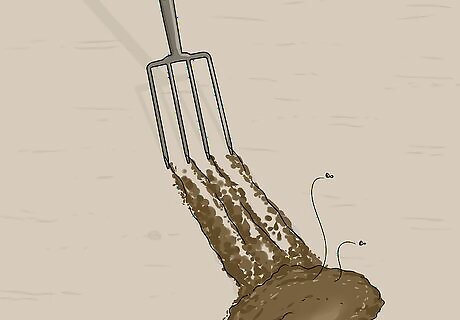
Revitalize infertile so it can grow plants again. Soil that has grown infertile after years or decades of farming will have little to no nutrients left over to grow new plant life. To revive infertile soil, pour a 2 inches (5.1 cm) layer of humus onto the soil and mix it in with a pitchfork. Apply another layer 2 inches (5.1 cm) thick 1 or 2 days later for extra nutrient-boosting support. Treat your active garden with humus once a year in the early springtime to keep the soil fertile and happy.
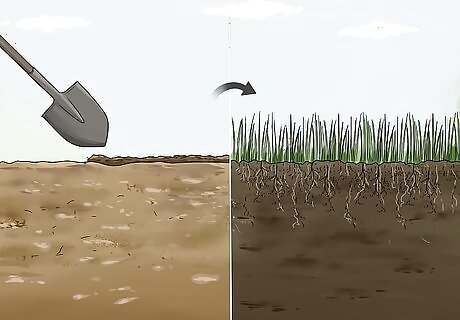
Turn compacted soil into fruitful gardening soil. Outdoor areas with lots of foot traffic will leave the soil too compacted, which isn’t conducive for plant life. To turn compacted soil into a fertile garden area, churn the soil with a pitchfork, breaking up any large clumps of dirt. Then, add a layer of humus about 2 inches (5.1 cm) thick and use a pitchfork to blend it into the soil. After you’ve added humus, wait 1 or 2 weeks before testing the soil with a pH strip to see if it has a reading of 6 to 8 (the only suitable range for growing plants).




















Comments
0 comment